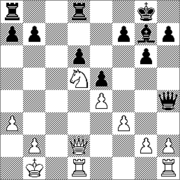Knight (chess)
|
|
| Chess pieces | |
|---|---|
| | King |
| | Queen |
| | Rook |
| | Bishop |
| | Knight |
| | Pawn |
The knight (Old English: cniht = 'boy', 'lad' or 'servant') (or, colloquially, horse) is a piece in the game of chess, representing a knight (armoured soldier) and often depicted as a horse's head. Each player starts with two knights on their first rank. In algebraic notation the white knights start on b1 and g1, while the black knights start on b8 and g8.
The knight move is unusual among chess pieces. It plays and captures alternately on white and black squares; each move may be described as stepping one square horizontally or vertically and then two squares perpendicular to the previous part of the move. The move is one of the longest surviving moves in chess having remained unchanged since before the seventh century AD. Because of this it also occurs in most Chess-related national games.
See the diagram to the left for the eight legal moves of a centralized knight. Unlike other chess pieces, the knight ignores any pieces in the path of its move, "jumping" directly to the destination square. Like most other pieces, it captures an enemy piece on its destination square.
Most pieces are more powerful if placed near the center of the board, but this is particularly true for a knight. A knight on the edge of the board attacks only four squares, and a knight in the corner only two. Moreover, it takes more moves for a decentralized knight to switch operation to the opposite side of the board than a decentralized bishop, rook, or queen. For these reasons the phrase, "A knight on the rim is grim" was coined. (Others say "A knight on the rim is dim.")
The knight is the only piece that can move at the beginning of the game before any pawn move has been made. Because of the above reasons, in most situations, the best square for the initial move of each knight is towards the center. Knights are usually brought into play slightly sooner than bishops, and much sooner than the rooks and the queen.
Note that the knight is the only piece that can be in position to attack a queen without being in the queen's line of attack. It is also not attacked by a king, bishop, or rook which it attacks. These features make the knight especially well-suited for executing a fork.
A knight is approximately equal in strength and value to a bishop. The latter's range is larger but the knight has the advantage of being able to reach any square of the board regardless of color. Since the knight is capable of jumping over obstructing pieces, it is considered to be more valuable earlier in the game when the board is more crowded. Also a crowded board provides more opportunity for the knight to execute forks. In endgames with pawns on both sides of the board, a knight is often not as good as a bishop, as it can only control squares on one side of the board at a time. With pawns on only one side, however, a knight can be more useful, as it is capable of controlling all squares, whereas a bishop can only ever control those of the same colour on which it stands.
Enemy pawns are very effective at harassing knights, because a pawn attacking a knight is not itself attacked by the knight. For this reason, a knight is most effective when placed in a "hole" in the enemy position, i.e. a square which can't be attacked by enemy pawns. In the diagram at right, white's knight on d5 is very powerful, more powerful than black's bishop on g7.
At the end of the game, if one side has only a king and a knight while the other side is down to nothing but its king, the game is a draw, since checkmate is impossible (this assumes all pawns have been captured). Indeed, if one side has two knights in addition to its king, checkmate can only occur if the opponent commits a blunder by moving the king to a square where it may be checkmated on the next move; a checkmate can never be forced. Checkmate can be forced, however, with a bishop and knight, or with two bishops, even though the bishop and knight are conceptually held to be of equal value.
In algebraic notation, the usual modern way of recording chess games, the letter N stands for the knight (K is reserved for the king); in descriptive chess notation, Kt is often used instead. In chess problems and endgame studies, the letter S, standing for the German name for the piece, Springer, is often used, N instead being used for the popular fairy chess piece, the nightrider.
See also
de:Springer (Schach) el:Ίππος (σκάκι) eo:Cxevalo (sxako) es:Caballo (ajedrez) it:Cavallo (Scacchi) ja:ナイト (駒) nl:Paard (schaken) no:Springer (sjakk) pl:Skoczek (szachy) pt:Cavalo (xadrez) sl:skakač (šah) sv:Springare

